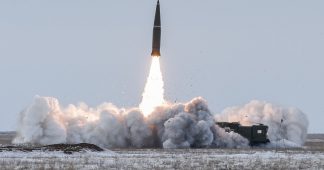“Modern nuclear-armed cruise missiles will be far more fearsome than those that were banned when the INF Treaty was signed in 1987”
Βυ Sun, Feb 24, 2019
In Greek mythology, Pandora had a box she had been warned to never open. With no understanding of the consequences, and despite the warning, she opened the box, irreversibly releasing the plagues that would affect all of humanity forever. The American threat to withdraw from the Intermediate Nuclear Forces Treaty, which prohibits possession of missiles capable of striking targets at ranges from about 300 to 3,400 miles, will have similar consequences for humanity if it is also executed in spite of warnings and without considering the consequences.
One particularly difficult aspect of this situation is that the Russians and the Americans each accuse the other of flouting the treaty’s purpose in Europe by planning for, or deploying, nuclear-capable weaponry that could have a dual use — defensive on its face but potentially offensive after quick modification. It is fair to say that each side has given the other a reason to fear its ultimate intent and that Americans must take the Russian position seriously. Unless both sides back away from their threats, accusations and suppositions about the other side, both will be in peril if the treaty is abandoned.
Consider this: Modern nuclear-armed cruise missiles will be far more fearsome than those that were banned when the I.N.F. Treaty was signed in 1987. Advances in computer electronics and guidance technologies have produced conventionally armed cruise missiles that can be commanded to change their routes and targets in flight, and loiter to attack at a programmed time.
With such capabilities, cruise missiles could be launched from many locations at once and could be detonated on numerous targets at once. The warning available would at best be ambiguous, no different from sensing the presence of shadows in a dark forest.
These terrifying new capabilities on both sides would substantially escalate the chances of a catastrophic accidental use of nuclear weapons during some as yet unforeseen crisis.
How did we get here? The path to the current crisis can be traced to September 2009, when President Barack Obama announced a new approach to American missile defense in Europe against long-range Iranian missiles. It would replace the George W. Bush administration’s plan for what was called Ground-Based Missile Defense sites in Poland and Romania, and Mr. Obama described his new Aegis-based European Phased Adaptive Approach as a “smarter and swifter” defense system. The installations would have a larger number of smaller and slower interceptors that would be guided by Aegis radars, normally used on United States Navy warships.
What Mr. Obama apparently did not know was that none of the radars associated with his program could see long-range Iranian warheads at a long-enough range to launch interceptors. That was a scandalous blunder, ascribable only to a lack of technical information from the Department of Defense and a failure of the White House and State Department policy staffs to adequately vet for the president the implications of the proposed change.
President Obama was probably also not told that the “Aegis ashore” installations in Poland and Romania could be armed quickly with offensive cruise missiles that would pose a threat of an immediate and ferocious attack on European Russia with only short warning.
In other words, the decision to place Aegis installations ashore in Europe produced no credible missile defense capabilities for the United States, but did create installations that could be rapidly armed with dozens — or hundreds — of offensive cruise missiles.
That is what the Russians have been reacting to since shortly after Mr. Obama decided to proceed with his plan.
Now the Trump administration’s stated reason for threatening to withdraw from the I.N.F. is Russia’s development of the SSC-8 cruise missile, also known as the 9M729, which appears to violate the clear limitations on weapons ranges established by the I.N.F. I leave it to others to argue whether the Russians have indeed violated the treaty; it is quite possible they have. But the SSC-8 missile appears to have characteristics similar to those of America’s Tomahawk sea-launched cruise missile. The Tomahawk could readily be stored at and launched from the Aegis sites.
Western news organizations have often treated as obfuscation the Russian claim that American missile defense installations have an offensive capability. But publicly available information makes it clear that the Aegis-based systems in Eastern Europe, if equipped with cruise missiles, would indeed violate the I.N.F.
Because the Aegis systems have so little use in interdicting Iranian-launched long-range missiles, it would be reasonable for Russian military planners and political leaders to wonder why the United States decided to base them in Eastern Europe. Could that decision indicate a strategic intention to expand and modify the system over time (which is happening now)?
The Russians insist that these dual-capability “Aegis ashore” installations violate the offensive weapons range limitations in the I.N.F. Treaty. The American government argues that its installations in Poland and Romania pose no threat to Russia because their computer software is incompatible with the launch of cruise missiles.
But the mechanical and electronic components installed in the Aegis ashore sites are not modified from those installed on Navy warships, which were designed to be able to simultaneously launch cruise missiles as well as anti-air missiles. Accepting the American position would require believing that a computer designed to read one brand of standardized flash drive could not read another standardized drive of a different size or brand.
The issues associated with preserving the I.N.F. Treaty are complex. Both sides have legitimate concerns that must be resolved if the pact is to be resurrected in the six months between the treaty suspensions announced this month and final withdrawal.
Facts support the Russian position. This reality must be taken into account if the United States and Russia (and possibly other countries) are to agree on continued control of intermediate-range missiles.
Both sides must stop and think about the common and avoidable danger they are creating by clinging to arguments about each getting some inconsequential military advantage. In fact, existing nuclear weapons systems can do anything imaginable, and much more that is unimaginable. It is the unimaginable capabilities of these weapons that must take center stage when considering the giant and still unknown terrors and threats they pose to global stability and humanity’s future.
America must recognize that the Obama administration inadvertently chose a land-based missile defense system with no defensive capacity that instead looks like a strike system to Russia. The Trump administration must stop its extremists from ending a meaningful treaty and putting the world on a faster path to oblivion. And the Russians need to pull back from their threats and boasts about their new missiles — a foolish and dangerous reaction to American bungling that plays against their own self-interest.
Everyone will win if the will exists to make those compromises. Everyone will lose if not.











